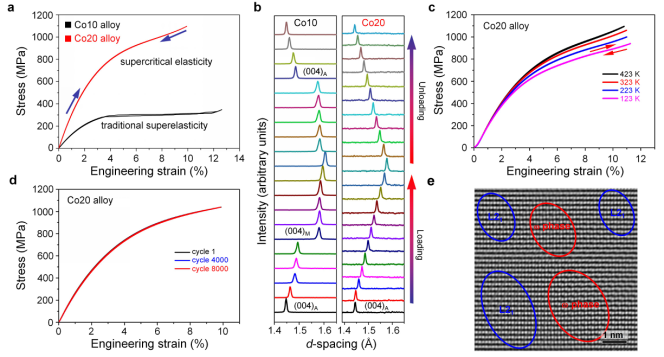Recently, Prof. WANG Yandong’s team at the Beijing Advanced Innovation Center for Materials Genome Engineering, State Key Laboratory for Advanced Metals and Materials, University of Science and Technology Beijing successfully prepared [001]-oriented NiCoFeGa single-crystal fibers with diameters between 30 and 500 mm, and lengths of more than 1 m. The fibers display high non-hysteretic superelasticity up to 15.2% and maximum stresses of ~1.5 GPa at room temperature. This alloy also exhibits unprecedented non-hysteretic superelasticity over a wide temperature range from 123 to 423 K with a small temperature dependence of the superelastic stress. Furthermore, this alloy demonstrates very large elastic energy storage capacity (~80 MJm-3) and excellent cyclic stability (8000 cycles) within 10%. Given these properties, the prepared NiCoFeGa alloy is expected to be useful in a wide variety of practical applications such as sensors and actuators in aeronautics and other fields.
Prof. WANG’s team has established long-term cooperation with overseas scholars at both Argonne National Laboratory and Oak Ridge National Laboratory. By in-situ synchrotron x-ray diffraction, neutron scattering and scanning transmission electron microscopy, the physical mechanism of the novel superelasticity was revealed. Its origin differs from the traditional superelasticity transformation from austenite to martensite via an abrupt lattice change, which correlates with a stress-induced continuous variation of the lattice parameter. The atomic entanglement state of the L21-type and w-like structures in the NiCoFeGa alloy leads to a complete suppression of the first-order martensitic shear transformation. Due to the mutual suppression and high-strength hindering plastic deformation, the first-order martensitic transformation turns into a continuous phase transition, also referred to as a second-order or higher-order phase transition in condensed matter. We denote this particular type of elasticity as supercritical elasticity (SCE).

Figure Supercritical elasticity of NiCoFeGa single-crystal fibers. (a) Comparison of stress-strain curves of traditional superelasticity and supercritical elasticity. (b) Variations in the d-spacing of the (004)A crystal plane during loading and unloading cycles for Co10 and Co20 fibers, showing distinct phase transformation characteristics. (c) Stress-strain curves of the Co20 fibers measured at 123, 223, 323, and 423 K showing a non-hysteretic superelasticity over a temperature range of at least 300 K. (d) Cyclic stress-strain curves of Co20 fiber performed up to 8,000 cycles at room temperature, without any degradation of the functional properties. (e) Inverse fast Fourier transformation of a high-angle annular dark-field image of the Co20 fibers annealed at high temperature. Due to the annealing at high temperature, atomic-scale entangled structures grow into more distinguishable L21 (magenta ellipses) and w-like (blue ellipses) structures.
The phenomenon of "supercritical elasticity" is similar to that of supercritical fluids. When the temperature and pressure of water are above its thermodynamic critical point, it enters a supercritical condition, where distinct liquid and gas phases do not exist. It can effuse through solids like a gas, and dissolve materials like a liquid. This supercritical phenomenon has been widely used in chemical and pharmaceutical fields. In the field of condensed matter physics, many important phenomena such as superconductivity and superfluidity are closely related to this supercritical transition. The discovery of supercritical elasticity in the NiCoFeGa alloy subverts the classic theory of martensitic transformation which previously indicated that obtaining non-hysteretic superelasticity was not possible.
The discovery of supercritical elasticity not only opens new avenues in the research of elastic strain engineering, but also opens a window into the field of shape memory alloys. By controlling the atomic entanglement state of the L21-type structure and w-like structure, other interesting physical phenomena are expected to be seen in condensed matter physics. Furthermore, the research of supercritical elasticity offers valuable new ideas and methods for studying critical phenomena and associated physical properties.
This work was published online by Nature Materials on March 16, 2020 (DOI: https://doi.org/10.1038/s41563-020-0645-4). Link to the paper: https://www.nature.com/articles/s41563-020-0645-4. The first author is CHEN Haiyang, a doctoral student of Prof. WANG Yandong’s group. Prof. WANG Yandong and Dr. REN Yang are the corresponding authors. The work was done in collaboration with NIE Zhihua, School of Materials Science and Engineering, Beijing Institute of Technology, SHEN Xi and YU Richeng, Institute of Physics, Chinese Academy of Sciences, and Levente Vitos, Department of Materials Science and Engineering, Royal Institute of Technology. The project was financially supported by the National Natural Science Foundation of China (Grant numbers: 51831003 and 51527801).